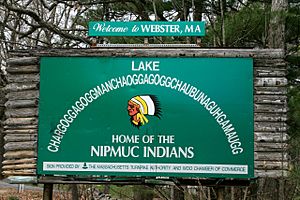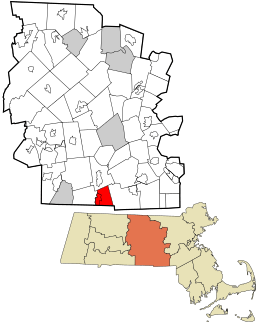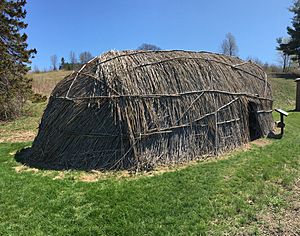Chaubunagungamaug Reservation facts for kids
Quick facts for kids
Chaubunagungamaug Reservation
|
|
|---|---|
|
State Indian Reservation
|
|

Sign with the 14-syllable long form alternate name for Lake Chaubunagungamaug that also acknowledges the Nipmuck presence in the town.
|
|

The Town of Webster, which contained the original reservation, within Worcester County and the Commonwealth of Massachusetts underneath the Town Seal.
|
|
| Country | United States |
| State | Massachusetts |
| County | Worcester |
| Praying Town of Chabanakongkomun | 1674-1675 |
| Dudley Indian (Chaubunagungamaug) Reservation | c. 1682-1887 |
| Chaubungaungmaug Reservation | 1981-present |
| Government | |
| • Type | Council meeting, with members elected from certain family lines. |
| Area | |
| • Total | 2.5 acre (1.0 ha) |
| Elevation | 506 ft (154 m) |
| Population
(2010)
|
|
| • Total | 0 |
| Time zone | UTC-5 (Eastern) |
| • Summer (DST) | UTC-4 (Eastern) |
| ZIP code |
01570
|
| Area code(s) | 508 / 774 |
| Website | Official CBNI Website: https://web.archive.org/web/20200219001336/http://generations-gifts.com/nipmuckcouncil/index.htm |
The Chaubunagungamaug Reservation is a small piece of land in Thompson, Connecticut. It is very close to the town of Webster, Massachusetts. This land is near Lake Chaubunagungamaug (also called Webster Lake) to the east and the French River to the west.
This reservation is used by the descendants of the Nipmuck Indians. These people were part of an earlier reservation that existed in the same area from around 1682 to 1869. Today, they are known as the Webster/Dudley Band of the Chaubunagungamaug Nipmuck. This group, along with the Hassanamisco Nipmuc, is officially recognized by the state of Massachusetts.
The reservation is only about 2.5 acres (1.0 hectare) in size. No one lives there permanently. However, it is an important place for the tribe. It serves as a meeting ground, a place for ceremonies, and a celebration area. The land is also used to re-bury the remains of local Native Americans. While Massachusetts recognizes the tribe and its reservation, they are not recognized by the state of Connecticut or by the United States federal government.
History of the Chaubunagungamaug Nipmuck
Early Praying Towns

The first efforts to set aside land for Native Americans in Massachusetts began with the 'Praying towns.' These towns were started by a missionary named John Eliot. The first one, Natick, was created in 1651. Eliot asked the colonial government to provide land for these towns. The government agreed in 1651 because the number of English settlers was growing quickly.
Eliot had learned the Native language and translated the Bible into it. He helped Native Americans learn to read and write. He settled Native converts, known as 'Praying Indians,' in these special communities. The Praying Towns were under the rules of the English colony. Praying Indians had to adopt many English customs, like their legal systems and Christianity. However, they were still able to govern themselves, using their own language and keeping many Native customs. Their leaders, who were often tribal elders, filled most of the administrative jobs.
In 1672, Joseph, the son of a leader named Petavit from Hassanamessit (Grafton, Massachusetts), began teaching in Chabanakongkomun. John Eliot and Major-General Daniel Gookin, who represented the colonial government, visited the area several times between 1668 and 1674. In 1673, Gookin appointed Willymachin, also known as Black James, as the leader (sachem) of Chabanakongkomun. Black James then became a constable for four new Praying Towns nearby.
Eliot and Gookin returned in 1674 to officially recognize Chabanakongkomun as a Praying Town, with Joseph as its teacher. This new town did not receive an official land grant at that time. It was still far from English settlements. Soon after, King Philip's War broke out in 1675-1676. This was a major conflict led by Metacomet against the English. During this war, Chabanakongkomun was abandoned. Many people joined Metacomet, while others helped the English as scouts. Those who remained faced very difficult times. Many were forced to go to Deer Island, where many suffered from hunger and sickness.

